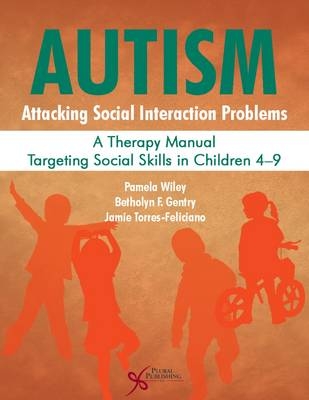
Autism: Attacking Social Interaction Problems
Plural Publishing Inc (Verlag)
978-1-59756-792-3 (ISBN)
- Titel z.Zt. nicht lieferbar
- Versandkostenfrei innerhalb Deutschlands
- Auch auf Rechnung
- Verfügbarkeit in der Filiale vor Ort prüfen
- Artikel merken
Autism: Attacking Social Interaction Problems: A Therapy Manual Targeting Social Skills in Children 4-9 includes sample parent letters, teacher letters, weekly skill steps, and simple stories to reinforce the information presented in the text as well as suggestions for extension activities. The AASIP program provides a comprehensive yet practical approach to teaching social communication skills across the life span to individuals with moderate to high functioning autism spectrum disorder and other diagnoses that result in social communication deficits. Children will enjoy engaging with their peers as they learn how to become social communicators and build their confidence.This user-friendly workbook includes 16 chapters divided into two units for children 4-6 and 7-9 years of age, allowing flexibility to select activities from either age group depending on the needs of the children. These lessons can be easily used in school settings as well as clinical settings.The AASIP program offers three additional books for children ages 10-12, the teen years, and a pre-vocational training manual for individuals 17 years to adulthood.Autism: Attacking Social Interaction Problems: A Therapy Manual Targeting Social Skills in Children 10-12"Autism: Attacking Social Interaction Problems: A Therapy Manual Targeting Social Skills in Teens"Autism: Attacking Social Interaction Problems: A Pre-Vocational Training Manual for Ages 17+
Preface. Acknowledgments. Chapter 1. Introduction. Chapter 2. Getting Started: Creating a Program.Chapter 3. Weekly Rituals. Unit I. Activities for 4- to 6-Year-Olds. Chapter 4. The ABCs of Life: Skills Needed for School Success :Lesson 1. Active Listening; Lesson 2. Following Directions; Lesson 3. Asking for Help. Chapter 5. How Are You Today? Dealing with Emotions: Lesson 1. Identifying Our Emotions; Lesson 2. Recognizing Emotions in Others; Lesson 3. The Right Emotion for the Right Situation. Chapter 6. Taking the First Step: Initiating Friendships: Lesson 1. Introducing Myself; Lesson 2. Initiating and Ending a Conversation; Lesson 3. Sharing is Caring. Chapter 7. Let the Games Begin: Being a Good Sport :Lesson 1. Asking to Play; Lesson 2. Taking Turns; Lesson 3. Winning, Losing, Compromising. Chapter 8. It's Raining Cats and Dogs: Figurative Language: Lesson 1. Understanding Idioms and Common Expressions. Chapter 9. "Grossology": Personal Hygiene: Lesson 1. First Impressions; Lesson 2. No More Gross; Lesson 3. The Unfriendly Germs. Chapter 10. Blending In: Everyday Situations: Lesson 1. Eating Out; Lesson 2. Birthday Party; Lesson 3. A Visit to the Dentist and Doctor. Chapter 11. Stranger Danger: Being Safe: Lesson 1. Who's a Stranger?; Lesson 2. Appropriate Versus Inappropriate Touching.Unit II. Activities for 7- to 9-Year-Olds. Chapter 12. The ABCs of Life: Skills Needed for School Success: Lesson 1. Active Listening; Lesson 2. Following Directions; Lesson 3. Asking for Help. Chapter 13. How Are You Today? Dealing with Emotions; Lesson 1. Identifying Our Emotions; Lesson 2. Recognizing Emotions in Others; Lesson 3. The Right Emotion for the Right Situation. Chapter 14. Taking the First Step: Initiating Friendships: Lesson 1. Who Should Be Your Friend; Lesson 2. How to Be a Good Friend; Lesson 3. Topic Maintenance. Chapter 15. Let the Games Begin: Being a Good Sport: Lesson 1. Asking to Play; Lesson 2. Taking Turns; Lesson 3. Winning, Losing, Compromising. Chapter 16. It's Raining Cats and Dogs: Figurative Language: Lesson 1. Understanding Idioms and Common Expressions; Lesson 2. Using Idiomatic Expressions. Chapter 17. "Grossology": Personal Hygiene": Lesson 1. First Impressions; Lesson 2. No More Gross; Lesson 3. The Unfriendly Germs. Chapter 18. Blending In: Everyday Situations: Lesson 1. Eating Out; :Lesson 2. Birthday Party; Lesson 3. Routines. Chapter 19. Stranger Danger: Being Safe: Lesson 1. Who's a Stranger; Lesson 2. Appropriate Versus Inappropriate Touching. Appendix A. Sample Parent Letters. Appendix B. Sample Teacher Letter. Appendix C. Sample Skill Steps. Appendix D. Sample Newsletter. Appendix E. Sample Data Tracking Form 1. Appendix F. Sample Data Tracking Form 2. References
| Verlagsort | San Diego |
|---|---|
| Sprache | englisch |
| Maße | 216 x 279 mm |
| Themenwelt | Medizin / Pharmazie ► Gesundheitsfachberufe ► Logopädie |
| Medizin / Pharmazie ► Medizinische Fachgebiete ► Neurologie | |
| Medizin / Pharmazie ► Medizinische Fachgebiete ► Pädiatrie | |
| ISBN-10 | 1-59756-792-2 / 1597567922 |
| ISBN-13 | 978-1-59756-792-3 / 9781597567923 |
| Zustand | Neuware |
| Haben Sie eine Frage zum Produkt? |
aus dem Bereich


